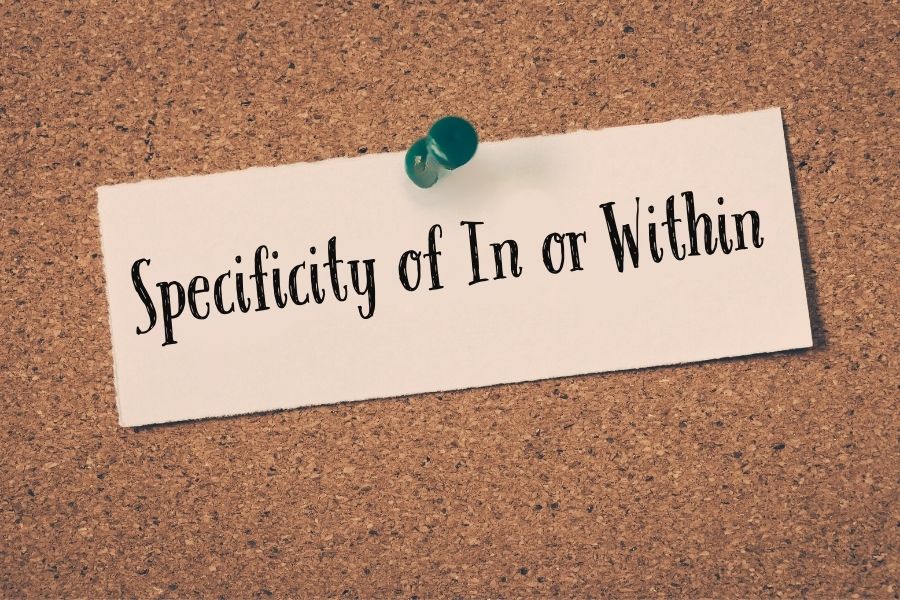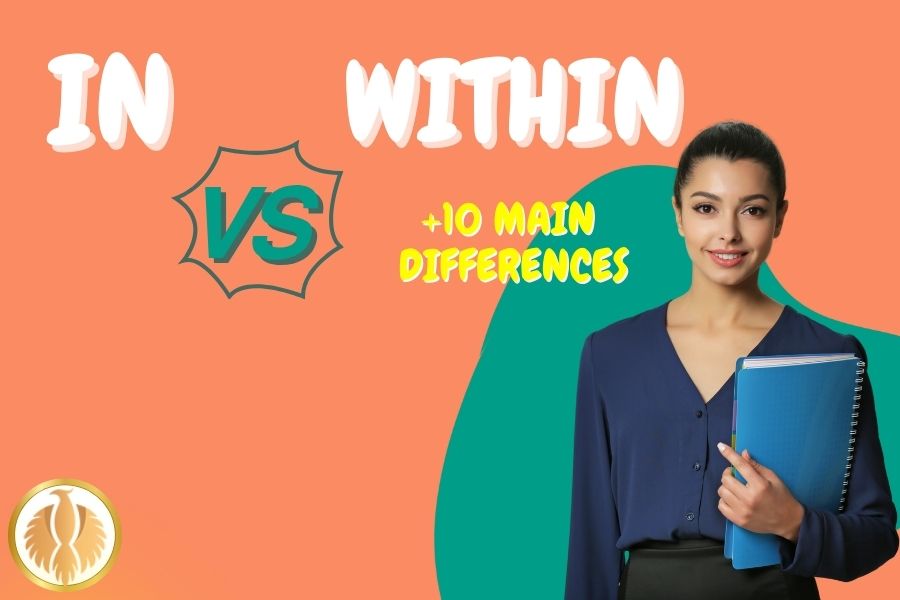In this article, we will explore the intriguing realm of English grammar, with a particular emphasis on the distinctions between the prepositions “in” and “within.”
At first glance, these two terms may appear alike, but they possess unique uses and meanings that can greatly enhance the clarity and precision of your communication.
Both “in” and “within” serve to denote location or inclusion, yet their subtle differences and specific contexts can differ.
Grasping these distinctions is essential for anyone aiming to excel in English grammar and apply these prepositions accurately in various situations.
Understanding “In”
The preposition “in” ranks among the most frequently used words in the English language. It is mainly employed to signify that something resides inside or is contained by a particular place or object. For instance:
- “The book is in the bag.”
- “She lives in New York.”
“In” can also be used to denote time, such as months, years, and periods of the day:
- “We will meet in December.”
- “He was born in 1990.”
- “I usually exercise in the morning.”
The Basics of “Within”
On the other hand, “within” is used to indicate that something is inside the limits of a particular area or period.
It often implies a sense of boundary or limit that is not necessarily physical.
“Within” can also be used to express a range or scope:
- “The temperature should stay within 20 to 25 degrees Celsius.”
- “She stayed within the budget.”
Key Differences
While both “in” and “within” can indicate location or inclusion, “within” often carries a connotation of boundaries or limits. “In” is more straightforward and is used in a broader range of contexts. Here comes some key differences:
- Physical vs. Abstract Boundaries: “In” is often used for physical locations, while “within” can be used for both physical and abstract boundaries.
- Time Frames: “In” is used for general time frames, whereas “within” is used for specific limits or deadlines.
- Inclusion: “In” indicates simple inclusion, while “within” suggests inclusion within a defined boundary.
- Flexibility: “In” is more flexible and can be used in a wider variety of contexts compared to “within.”
Examples and Usage
To better understand these differences, let’s look at some examples:
- In: “She is in the garden.” (She is physically inside the garden.
- Within: “She is within the garden walls.” (She is inside the boundaries of the garden walls.)
- In: “We will finish the project in a week.” (General time frame.)
- Within: “We will finish the project within a week.” (Specific deadline.)
Practical Tips
To use “in” and “within” correctly, consider the following tips:
- Context Matters: Always consider the context in which you are using these prepositions. If you are talking about physical locations, “in” is usually appropriate. If you are discussing limits or boundaries, “within” might be better.
- Specificity: Use “within” when you want to emphasize a specific boundary or limit.
- Practice: Practice using these prepositions in different sentences to get a feel for their nuances.
Understanding the differences between “in” and “within” can greatly enhance your English grammar skills.
By paying attention to the context and the specific nuances of each word, you can use these prepositions more accurately and effectively.
This will not only improve your writing but also make your speech sound more natural and precise.
which one is right -In or Within? What’s the main answer?

Both “in” and “within” can be used to show where or when something is, but they kinda mean different things and are used differently.
“In” is used to show that something is inside or enclosed within a space or time frame.
It suggests a more general or less specific where or when. For example, “I’m in the room” or “The event is gonna happen in June.
” “Within” is used to show that something is inside or enclosed within a specific space or time frame. It suggests a more exact or limited where or when.
For example, “The book is inside the drawer” or “The project has to be finished within two weeks.
” The choice between “in” and “within” depends on the specific situation and how exact or specific you want to be.
1.Definition and Usage of In vs Within in English Grammar

In English grammar, the words “in” and “within” are used to show where something is or if it’s included.
They might seem similar, but they have different meanings and uses. Knowing the difference between these two words is really important for clear and effective communication.
“In” is often used to say that something is inside a specific area or space. It means that it’s contained or surrounded by something.
For example, if we say “She is in the room”, it means that the person is inside the room.
It suggests that the person is within the room’s boundaries and surrounded by its walls or space. On the other hand, “within” is used to say that something is inside a bigger area or boundary.
It means that it’s part of something larger. For instance, if we say “The book is within the bag”, it means that the book is inside the bag, which is part of a bigger space.
It shows that the book is contained within the bag’s boundaries. To explain the difference more, let’s look at another example.
Imagine a park with a playground. If someone says “The children are playing in the park”, it means that the children are doing activities within the park’s boundaries.
But if someone says “The children are playing within the park”, it means that the children are playing in specific areas or zones designated within the park, like the playground or a designated play area.
It’s important to remember that using “in” or “within” depends on the situation and what you’re trying to say.
Generally, “in” is used when talking about a specific location or enclosed space, while “within” is used to emphasize being inside a bigger area or boundary.
So to sum it up, “in” is used to show that something is inside a specific area, while “within” is used to show that something is inside a larger area or boundary. Understanding the small differences in how they’re used can help you communicate accurately and precisely in English grammar.
You might also enjoy: Totalled Vs Totaled: 10 Main Differences + Examples [2023]
2.Physical vs. Abstract of in and within
In English grammar, the usage of “in” and “within” can be different based on if they are used in a physical or not-so-real sense.
When you say something is “in” a physical sense, you mean it’s inside a specific area or object. Like, if you say “The cat is in the box,” you mean the cat is physically inside the box.
On the other hand, when you say something is “within,” you mean it’s contained within a bigger area or boundary.
For example, if you say “The park is within the city,” you mean the park is inside the boundaries of the city. In a not-so-real sense, when you use “in,” you mean something is involved or included in a specific concept or situation.
Like, if you say “She is in love,” you mean the person is feeling the emotion of love. On the other hand, when you use “within,” you mean something is more precise or limited within an abstract concept.
For instance, if you say “The answer lies within yourself,” you mean the answer can be found internally, in your own thoughts or feelings.
In summary, when you use “in” in a physical sense, it means being physically located inside a specific area, while “within” means being contained within a bigger area.
In a not-so-real sense, “in” means involvement or inclusion, while “within” means a more limited scope within an abstract concept.
3.Specificity of “In or Within

In English grammar, the words “in” and “within” are also different when it comes to how specific they are. “In” is usually used to talk about a bigger or less specific place or including something.
It means being inside a general area or thing without giving the exact boundaries. For example, when we say “He lives in the city,” it means the person lives somewhere in the city, but we don’t know the exact spot.
On the other hand, “within” is used to show a higher level of detail. It means being inside a more precisely defined area or limit.
For instance, when we say “The keys are within the drawer,” it means the keys are inside a specific drawer, which is a more particular place inside a bigger space.
To sum it up, we use “in” when talking about a wider or less specific place, while we use “within” to talk about a more exact or specific place inside a bigger area or thing.
4.Time Expressions of “In” vs. “Within”
In English, we use the words “in” and “within” a lot to talk about time. They both have to do with time, but they’re a little different.
“In” is used for a general time or a specific point in time, while “within” means before a certain deadline or limit. For example, if someone says, “I’ll finish the project in two weeks,” that means they’ll finish it at some point during those two weeks.
But if they say, “I’ll finish the project within two weeks,” that means they’ll finish it before the two weeks are up. Knowing the difference between these two words can help you talk about time and deadlines in different situations.
You might also enjoy: Freshman Vs Freshmen: 10 Main Differences/Similarities
5.Formality and Register of “In” vs. “Within” in English Grammar

In English grammar, the choice of prepositions can really affect how formal and proper a sentence sounds.
The words “in” and “within” are no different – they have different meanings and are used in different situations.
Knowing when to use each one is important for speaking and writing in the right way. “In” is more casual and is used a lot in everyday language. You’ll hear it in casual conversations and see it in informal writing.
For example, phrases like “in the morning,” “in the park,” or “in my opinion” are used a lot in informal situations. Since “in” can be used in so many different situations, it’s a popular choice for informal communication.
On the other hand, “within” is more formal. You’ll see it in professional or academic writing, formal speeches, and formal settings. “Within” is used to be more precise and to set boundaries.
For example, phrases like “within the scope of this study,” “within the organization’s policies,” or “within the legal framework” are used in formal situations.
Using “within” makes the language sound more formal and precise, which is good for professional or academic communication.
Whether to use “in” or “within” also depends on how formal the whole sentence or conversation is. If it’s more casual, go with “in” because it’s simpler and easier to understand.
If it’s more formal, use “within” to sound more professional. It’s important to remember that the formality of “in” and “within” can also change depending on the specific situation and the people you’re talking to.
For example, in technical or specialized fields, it might be more common to use “within” even in less formal situations to make sure everything is accurate and clear.
So, in summary, choosing between “in” and “within” in English grammar can really affect how formal and proper a sentence sounds.
“In” is more casual and used a lot in everyday language, while “within” is more formal. Knowing when to use each one is important for effective communication in both formal and informal situations.
6.Idiomatic Expressions of “In” and “Within” in English Grammar
In English grammar, the expressions “in” and “within” are often used to show where or when something is. Both words can mean being inside or surrounded, but there are slight differences in how they are used.
“In” is usually used to show being inside a specific place or area. It suggests being contained or surrounded by something.
For example, if you say “She is in the room,” it means the person is physically inside the room. Similarly, if you say “I live in New York,” it means the person resides within the city. On the other hand, “within” is used to show being inside a specific boundary or timeframe.
It suggests a more precise or limited location or time frame. For instance, if you say “The keys are within the drawer,” it means the keys can be found inside the boundaries of the drawer.
Likewise, if you say “I will finish the report within two days,” it means the report will be completed within the specified time frame.
It’s important to note that whether you use “in” or “within” depends on the context and the intended meaning. “In” is more commonly used and has a broader application, while “within” is often used when talking about a specific boundary or timeframe.
To sum it up, the expressions “in” and “within” in English grammar show being inside or surrounded. “In” is used to show a general location or area, while “within” is used to show a more specific boundary or timeframe.
Understanding the slight differences between these two expressions can help you use them correctly in different situations.
7.Understanding the Limitations and Contextual Challenges of “In” and “Within” in English Grammar

In English grammar, the idiomatic expressions “in” and “within” have their uses, but it’s important to know their limitations and potential confusion.
“In” is very broad and can sometimes be confusing. For example, if someone says “He is in the office,” it could mean they are physically inside the office or just associated with it.
This lack of specificity can create confusion in certain situations. On the other hand, “within” is more specific and indicates a specific boundary or timeframe.
However, it may not always be the best choice when talking about a general location. For instance, saying “I live within New York” may sound strange, as we typically use “in” for living in a city or region.
Another limitation of both “in” and “within” is that their meaning depends on the context. For example, if someone says “The book is in the library,” it could mean it’s physically inside the library or it belongs to the library’s collection.
Without more context, it can be hard to know the exact meaning. Also, idiomatic expressions in any language have exceptions or variations that can make them even more complicated.
English grammar is no different, and sometimes “in” or “within” might not follow the general rules. So, while “in” and “within” have their uses, they also have limitations.
“In” can be broad and potentially confusing, while “within” is more precise but may not always work for general locations.
Context is key to understanding the intended meaning, and there may be exceptions or variations to these expressions that make them even more complicated.
You might also enjoy: Affirm Vs Confirm In English: 10 Differences You Need To Know
8.Scope of “In” and “Within”
In English grammar, the words “in” and “within” have a lot of different ways to use them.
Both words are prepositions that show where something is, when something happens, or the limits of something, but they have slightly different meanings and uses.
The word “in” has a wide range of meanings and is commonly used to show that something is inside a specific place, area, or container. It can also show that something is part of a group or category.
For example, if someone says “She is in the park,” it means that the person is physically inside the park. Similarly, if someone says “I work in the marketing department,” it means that the person is part of the marketing department. Also, “in” can be used to show when something happens.
For example, if someone says “The meeting will take place in the afternoon,” it means that the meeting is scheduled to happen during the afternoon. On the other hand, the word “within” has a more specific meaning and is often used to show a precise location, limit, or time frame.
It means that something is inside a specific boundary or constraint. For example, if someone says “The keys are within the drawer,” it means that the keys can be found inside the boundaries of the drawer.
Similarly, if someone says “I will finish the report within two days,” it means that the report will be completed within the specified time frame of two days. Also, “within” can be used to show that something is in conformity or compliance with rules, regulations, or expectations.
For example, if someone says “The company operates within the legal framework,” it means that the company follows the laws and regulations. In summary, “in” and “within” have many different uses in English grammar.
“In” can show where something is, when something happens, and inclusion, while “within” is more specific and shows precise boundaries, time frames, or compliance. Understanding the different meanings of these words can help in using them correctly and effectively in different grammatical situations.
9. Inclusion vs. Exclusion

“In” basically means you’re part of a bigger group or category, while “within” means you’re inside a specific subset or subgroup.
10.Distance of “In” and “Within”
When you say “in”, it means you’re inside some place, no matter how far it is. But when you say “within”, it means you’re closer or the distance is shorter.
You might also enjoy: Difference Between Ensure VS Make Sure [2023]
Conclusion:
Grasping the distinction between “in” and “within” in English grammar is essential for effective and accurate communication.
While these two prepositions may appear similar at first, they possess unique meanings and applications that can greatly enhance the clarity of your spoken and written words.
Why It Matters
Understanding when to use “in” as opposed to “within” allows you to express your ideas with greater precision.
For example, “in” typically refers to a broad location or time period, whereas “within” implies a more defined boundary or limit.
This difference is especially significant in both informal and formal conversations, ensuring your audience comprehends your intended message.
Practical Applications
Look at these examples:
- Location: When you say, “The keys are in the drawer,” you’re referring to a general area. Conversely, saying, “The keys are within the drawer,” highlights that the keys are inside the drawer’s confines, possibly indicating they are not easily seen or are located in a specific section.
- Time: Saying, “I’ll finish the report in a week,” provides a general timeframe. In contrast, “I’ll finish the report within a week,” establishes a specific deadline, making it clear that the task will be completed no later than one week from now.
Enhancing Your Communication
By becoming proficient in the use of “in” and “within,” you can elevate the nuance and precision of your communication.
This skill is particularly beneficial in professional environments where clarity and specificity are crucial.
For instance, in project management, stating that a task will be completed “within three days” sets a clear expectation, while saying it will be done “in three days” may introduce some uncertainty.
Mastering Prepositions: Helpful Hints
Here are some helpful hints to enhance your understanding of “in” and “within”:
1.Practice Often: Make it a habit to use these prepositions in your everyday discussions and writing. The more frequently you apply them, the more instinctive they will feel.
2.Consider the Context: Always think about the situation in which you’re using these terms. Decide if you’re referring to a broad location or time (“in”) versus a specific limit or boundary (“within”).
3.Learn from Real-Life Examples: Observe how native speakers utilize these prepositions in various situations. Engaging with books, articles, and conversations can offer you valuable perspectives.
4.Seek Feedback: If you’re uncertain about your usage, feel free to reach out for feedback from teachers, friends, or language partners. Constructive input can significantly aid your progress.
Cultural Awareness
In some cultures, precision and clear boundaries are highly appreciated, while others may favor a more general approach.
Being aware of these subtleties can help you engage in conversations more smoothly and minimize misunderstandings.
To wrap things up, understanding the distinction between “in” and “within” is a small yet important step in enhancing your English grammar skills.
These prepositions may seem straightforward, but they are vital for ensuring your communication is clear and effective.
By grasping their unique applications and practicing consistently, you can improve your ability to express your ideas accurately.
Remember, learning a language is a continuous journey. Every new word or phrase you learn takes you closer to becoming fluent.
Keep practicing, stay curious, and don’t shy away from making mistakes. Each mistake is an opportunity to grow and enhance your skills.
I hope you found it helpful and informative. If you have any questions or need more details about any of the topics discussed, feel free to get in touch.
Also, be sure to explore more of our resources for extra tips and lessons on English grammar.

Hi, welcome to my blog! My name is Omid and I am thrilled to have you here! I am an English language teacher with 12 years of experience and hold multiple international certifications (TESOL, IELTS, TOEFL, PTE, CELTA). Additionally, I hold a PhD in Applied Linguistics with a specialization in Teaching English as a Second Language (TESL), which fuels my passion for teaching English and assisting others in mastering the language. To me, nothing is more rewarding than helping individuals enhance their English language abilities through various methods. So, let’s embark on this journey of learning English together.




